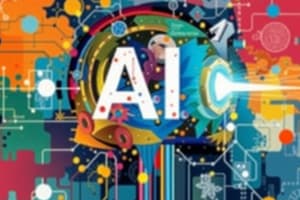Podcast
Questions and Answers
What is the main difference between symbolic AI and sub-symbolic AI?
What is the main difference between symbolic AI and sub-symbolic AI?
- Symbolic AI is more successful in pattern matching while sub-symbolic AI is more successful in natural language processing
- Symbolic AI simulates high-level conscious reasoning while sub-symbolic AI is a move away from explainable AI (correct)
- Symbolic AI is explainable while sub-symbolic AI is not
- Symbolic AI is used for unsupervised learning while sub-symbolic AI is used for supervised learning
What is the main concern regarding the development of AI?
What is the main concern regarding the development of AI?
- The potential for AI to surpass human intelligence
- The potential for AI to revolutionize many industries
- The potential for AI to be misused or abused, leading to harm to humans or society as a whole (correct)
- The potential for AI to be too expensive to develop
What is the difference between soft computing and hard computing?
What is the difference between soft computing and hard computing?
- Soft computing uses techniques that are tolerant of imprecision, uncertainty, and approximation while hard computing uses exact algorithms (correct)
- Soft computing is used for reasoning while hard computing is used for perception
- Soft computing is more successful in computer vision while hard computing is more successful in natural language processing
- Soft computing is used for supervised learning while hard computing is used for unsupervised learning
Study Notes
Overview of Artificial Intelligence (AI) and its History
-
AI is the ability of machines to perceive, synthesize, and infer information, demonstrated through tasks such as speech recognition, computer vision, and translation.
-
AI applications include web search engines, recommendation systems, self-driving cars, and creative tools, among others.
-
AI has experienced waves of optimism, disappointment, and renewed funding since its founding as an academic discipline in 1956.
-
AI research has tried and discarded many different approaches, with highly mathematical and statistical machine learning dominating in the 21st century.
-
The sub-fields of AI research are centered around particular goals, such as reasoning, knowledge representation, planning, learning, and perception.
-
The original goal of AI was to create versatile, fully intelligent machines, but much of current research involves statistical AI, which is used to solve specific problems.
-
AI has had a significant impact on industry and academia, with the amount of research into AI increasing by 50% from 2015-2019.
-
The traits or capabilities of AI that researchers expect an intelligent system to display include reasoning, problem-solving, knowledge representation, learning, natural language processing, perception, and social intelligence.
-
Machine learning is a fundamental concept of AI research and includes supervised, unsupervised, reinforcement, and transfer learning.
-
Natural language processing allows machines to read and understand human language and has applications in information retrieval, question answering, and machine translation.
-
Machine perception is the ability to use input from sensors to deduce aspects of the world and includes computer vision, speech recognition, and facial recognition.
-
Affective computing is an interdisciplinary umbrella that comprises systems that recognize, interpret, process, or simulate human feeling, emotion, and mood.Overview of Artificial Intelligence
-
Artificial General Intelligence (AGI) aims to develop machines that can solve a wide range of problems with versatility similar to human intelligence.
-
Different approaches to AGI include incorporating work from individual domains into a multi-agent system, finding a "master algorithm," or utilizing anthropomorphic features.
-
AI tools like search and optimization algorithms use heuristics and rules of thumb to prioritize choices and limit the search for solutions into a smaller sample size.
-
Logic is used for knowledge representation and problem-solving, with different forms like propositional logic, fuzzy logic, and modal logics designed to handle specific domains of knowledge.
-
Probabilistic methods, including Bayesian networks and decision theory, are used to solve problems with incomplete or uncertain information.
-
Classifiers and statistical learning methods are used for pattern matching and decision-making, including decision trees, k-nearest neighbor algorithm, and neural networks.
-
Deep learning uses several layers of neurons to extract higher-level features from raw input and has improved performance in computer vision, speech recognition, and image classification.
-
Specialized programming languages for AI, like Lisp and TensorFlow, have been developed, as well as hardware like neuromorphic computing and AI accelerators.
-
AI applications are pervasive and used in search engines, recommendation systems, virtual assistants, autonomous vehicles, and image labeling, among others.
-
AI has been successful in game playing, including chess, Jeopardy!, and Go, as well as predicting judicial decisions, creating art, and proving mathematical theorems.
-
AI content detector tools use algorithms to analyze and detect specific types of content in digital media, such as inappropriate speech, violent or sexual images, and spam.
-
Smart traffic lights, developed by Carnegie Mellon, have been installed in 22 cities and have reduced drive time by 25% and traffic jam waiting time by 40% at intersections.
-
AI is the most prolific emerging technology in terms of patent applications and granted patents, with machine learning being the dominant AI technique disclosed in patents. Companies represent the majority of top AI patent applicants.Artificial Intelligence: Philosophy, Approaches, Risks, and Future
-
AI can be categorized into sectors such as finance, transportation, life and medical sciences, personal devices, computing, human-computer interaction, and others.
-
IBM has the largest portfolio of AI patents with 8,290 patent applications, followed by Microsoft with 5,930 patent applications.
-
Alan Turing proposed the question of whether machines can show intelligent behavior, leading to the Turing test that measures a machine's ability to simulate human conversation.
-
AI must be defined in terms of "acting" and not "thinking," and intelligence is defined as the computational part of the ability to achieve goals in the world.
-
Symbolic AI simulates high-level conscious reasoning, but it failed on tasks such as learning, recognizing an object, or commonsense reasoning.
-
Sub-symbolic AI is a move away from explainable AI, and the emerging field of neuro-symbolic AI attempts to bridge symbolic and sub-symbolic approaches.
-
Soft computing uses techniques that are tolerant of imprecision, uncertainty, and approximation, and most successful AI programs in the 21st century are examples of soft computing with neural networks.
-
AI researchers are divided on whether to pursue artificial general intelligence and superintelligence or to solve specific problems in hopes of indirectly achieving the long-term goals.
-
Superintelligence may dramatically surpass humans, leading to the technological singularity or the merging of humans and machines into cyborgs.
-
AI risks include technological unemployment, bad actors and weaponized AI, algorithmic bias, and existential risks such as superintelligence that humans cannot control.
-
Bias can be inadvertently introduced by the way training data is selected, and AI poses a risk to mankind, however humble or "friendly" its stated goals might be.
-
Experts and industry insiders have expressed mixed opinions on AI risks, with some committing to responsible AI development and others arguing that the risks are far enough in the future to not be worth researching.
-
AI has the potential to improve productivity and solve complex problems, but it requires ethical considerations and responsible development to ensure that the benefits outweigh the risks.Artificial Intelligence: Ethics, Regulation, and Fiction
-
Artificial Intelligence (AI) refers to the ability of machines to perform tasks that typically require human intelligence, such as visual perception, speech recognition, decision-making, and language translation.
-
AI has the potential to revolutionize many industries, from healthcare and finance to transportation and manufacturing, but it also raises ethical, legal, and social issues that need to be addressed.
-
One of the main concerns is the potential for AI to be misused or abused, either intentionally or unintentionally, leading to harm to humans or society as a whole.
-
Some experts argue that developing "friendly AI" or ethical machines should be a higher research priority to minimize risks and ensure that AI benefits humans.
-
The regulation of AI is an emerging issue in jurisdictions globally, with more than 30 countries adopting dedicated strategies for AI between 2016 and 2020.
-
The Global Partnership on Artificial Intelligence was launched in June 2020, stating a need for AI to be developed in accordance with human rights and democratic values.
-
In fiction, AI has been a persistent theme, with works such as Mary Shelley's Frankenstein, Arthur C. Clarke's and Stanley Kubrick's 2001: A Space Odyssey, and Isaac Asimov's Multivac series exploring the risks and benefits of AI.
-
Asimov introduced the Three Laws of Robotics, which are often brought up during lay discussions of machine ethics, but AI researchers generally consider them useless due to their ambiguity.
-
Transhumanism, the merging of humans and machines, is explored in works such as the manga Ghost in the Shell and the science-fiction series Dune.
-
Several works use AI to force us to confront the fundamental question of what makes us human, showing artificial beings that have the ability to feel and suffer, such as in Karel Čapek's R.U.R., Philip K. Dick's Do Androids Dream of Electric Sheep?, and the films A.I. Artificial Intelligence and Ex Machina.
-
Copyright issues arise with AI's decision-making abilities and the legal responsibility and copyright status of created works.
-
The field of machine ethics provides machines with ethical principles and procedures for resolving ethical dilemmas, such as Stuart J. Russell's three principles for developing provably beneficial machines and Wendell Wallach's "artificial moral agents".
Studying That Suits You
Use AI to generate personalized quizzes and flashcards to suit your learning preferences.
Description
Think you know all about Artificial Intelligence (AI)? Test your knowledge with our quiz and learn more about the history, philosophy, approaches, risks, ethics, regulation, and fiction surrounding this thriving field. From the basics of machine learning and natural language processing to the potential risks of superintelligence and algorithmic bias, this quiz covers a broad range of topics related to AI. Challenge yourself and see how much you really know about this rapidly evolving technology.




